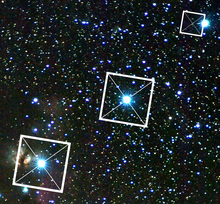
Back نظرية ارتباط الجبار Arabic Teoría de la correlación de Orión Spanish Théorie de la corrélation d'Orion French Teoria della correlazione di Orione Italian Teoria da correlação de Orion Portuguese Корреляционная теория Ориона Russian


- Alnitak on the Great Pyramid of Giza
- Alnilam on the pyramid of Khafre
- Mintaka on the pyramid of Menkaure
The Orion correlation theory is a fringe theory in Egyptology attempting to explain the arrangement of the Giza pyramid complex.
It posits that there is a correlation between the location of the three largest pyramids of the Giza pyramid complex and Orion's Belt of the constellation Orion, and that this correlation was intended as such by the original builders of the Giza pyramid complex. The stars of Orion were associated with Osiris, the god of rebirth and afterlife by the ancient Egyptians.[1][2][3] Depending on the version of the idea, additional pyramids can be included to complete the picture of the Orion constellation, and the Nile river can be included to match with the Milky Way.
The idea was first published in 1989 in Discussions in Egyptology, volume 13. It was the subject of the book The Orion Mystery, in 1994,[4] as well as a BBC documentary, The Great Pyramid: Gateway to the Stars (February 1994), and appears in some New Age books.[5][6]
- ^ The Oxford Guide: Essential Guide to Egyptian Mythology, Edited by Donald B. Redford, p302-307, Berkley, 2003, ISBN 0-425-19096-X
- ^ Mackenzie, Donald A. (1907). "Triumph of the Sun God". Egyptian Myth and Legend. Gresham Pub. Co. pp. 167–168. ISBN 978-0-517-25912-2.
- ^ "Orion". Constellationsofwords.com. Retrieved 2012-12-07.
- ^ Robert Bauval, Adrian Gilbert, The Orion Mystery: Unlocking The Secrets of the Pyramids (London: Heinemann, 1994). ISBN 0-434-00074-4
- ^ Adrian Gilbert (2001). Signs in the sky: the astrological & archaeological evidence for the birth of a new age. Three Rivers Press. pp. 61–66. ISBN 978-0-609-80793-4.
- ^ Philip Coppens (2004). The Canopus Revelation: The Stargate of the Gods and the Ark of Osiris. Adventures Unlimited Press. p. 30. ISBN 978-1-931882-26-2.